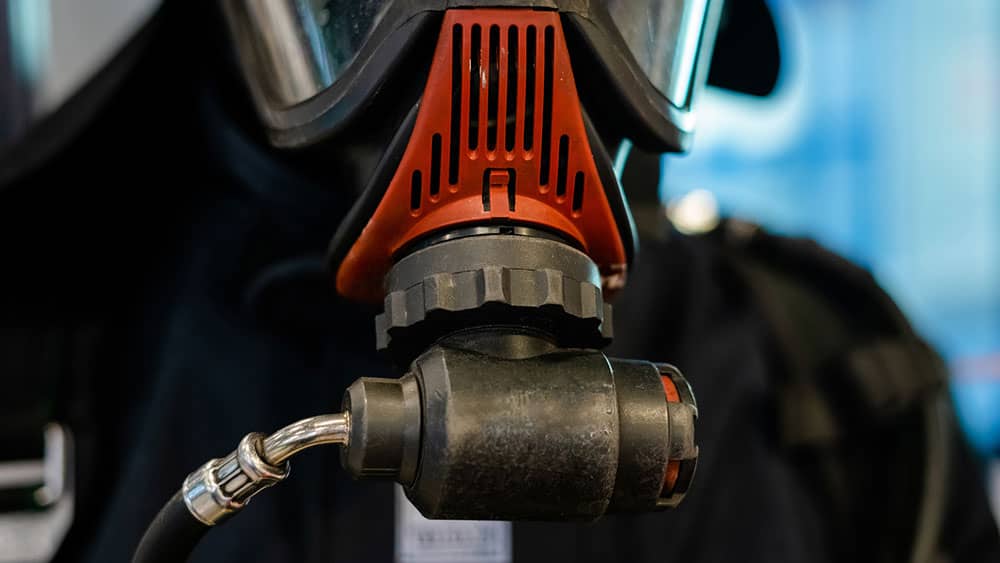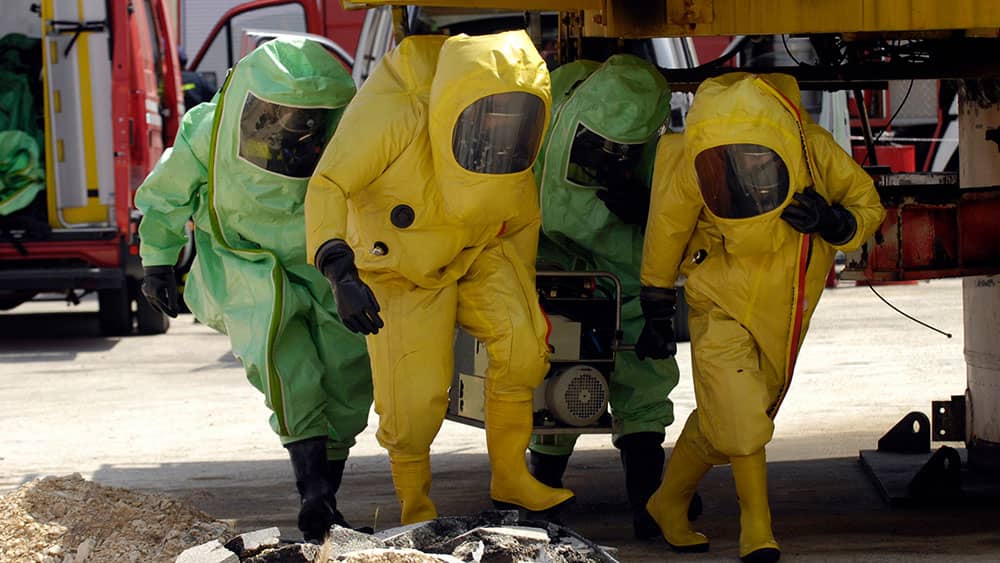HAZWOPER Training 16-Hour Advancement Training — Waste Site Workers
This high-impact, multi-course HAZWOPER training covers the essentials of hazardous substance removal or other exposure activities by general waste site workers.

According to OSHA, a "cleanup operation" is an operation where hazardous substances are removed, contained, incinerated, neutralized, stabilized, cleared-up, or in any other manner processed or handled with the goal of making the site safer for people or the environment. All employees working on sites with cleanup operations covered by the HAZWOPER standard must receive training if they are exposed to hazardous substances, health hazards, or safety hazards.
Normally, routine site workers[1] and non-routine site workers[2] must receive a minimum of 24-hours initial off-site training and at least one day of actual field experience under the direct supervision of a trained, experienced supervisor. However, according to OSHA, if a fully trained routine or non-routine site worker now becomes a general site worker[3] OR is required to wear a respirator, then he or she must have:
- An additional 16 hours of initial off-site training, and
- Two more days of actual field experience.
The additional training and field experience brings the total initial training and experience durations up to those mandated for a general site worker, which is 40-hours initial off-site training and three days field experience.
HAZWOPER 16-Hour Advancement Training: Waste Site Workers Curriculum
There are eight online, e-learning courses included within the HAZWOPER 16-Hour Advancement Training: Waste Site Workers Curriculum:
HAZWOPER: Hazardous Substance Recognition and Identification
This HAZWOPER training helps educate employees about recognizing and identifying hazardous substances, as well as what to do during a hazardous substance emergency.
HAZWOPER: Respiratory Protection
This Hazwoper training course informs learners about the purpose of respirators, the equipment to use, and how to use and clean them properly.
HAZWOPER: Health and Physical Hazards
This HAZWOPER training creates awareness to hazards that may be present when working at a hazardous waste cleanup site or responding to an emergency release.
HAZWOPER: Radiation and Biological Exposures
This HAZWOPER training course is designed to familiarize workers with the types of radiation they may encounter at work, dose limits, postings, and how to minimize exposure to radiation.
HAZWOPER: Written HAZWOPER Plans and Programs
This HAZWOPER training course is designed to focus on the plans and programs that are required prior to conducting any work at a hazardous waste cleanup site.
HAZWOPER: Temperature Extremes
This HAZWOPER training course is designed to inform cleanup site workers about the dangers of working in extreme temperatures, the signs and symptoms to watch for in temperature-related injury or illness, how to respond to signs and symptoms, and how to protect themselves when working in temperature extremes.
HAZWOPER: Fire Prevention and Protection
This HAZWOPER training course is designed to address the fire basics at any hazardous waste cleanup site.
HAZWOPER: Electrical Safety and Lockout/Tagout
The HAZWOPER training course familiarizes workers with the basics of electrical safety, how to recognize and avoid electrical hazards, what hazardous energy is, and how to properly perform lockout/tagout procedures to help avoid incidents involving electricity and other hazardous energy.
Intended Audience: Any employees who may be involved or expected to engage in hazardous waste cleanup operations where the employee may be exposed to hazardous substances, health hazards or safety hazards. These cleanup workers include:
- General site workers, such as equipment operators, general laborers and supervisory personnel
- Workers on the site only occasionally for a specific limited task (ie: groundwater monitoring, land surveying or geo-physical surveying) and who are unlikely to be exposed over permissible exposure limits
- Workers regularly on the site who work in areas which have been monitored and fully characterized indicating that exposures are under permissible exposure limits where respirators are not necessary, and the site characterization indicates that there are no health hazards or the possibility of an emergency developing
Copyright Date:
- 2018
IMPORTANT NOTE: In OSHA's view, HAZWOPER online training, by itself, is not sufficient to meet the intent of the agency's training requirements for HAZWOPER, 29 CFR 1910.120 for general industry or 29 CFR 1926.65 for construction. Therefore, online training must be supplemented by site-specific elements, hands-on training and exercises, and an opportunity for trainees to ask questions of a qualified trainer. When using this course curriculum as a tool to help with training under §1910.120(e)/§1926.65(e), we suggest you:
- Ensure your trainer is qualified, in accordance with §1910.120(e)(5)/§1926.65(e)(5);
- Augment the online training with site-specific elements;
- Tailor your training to the employees' assigned duties;
- Include hands-on training to familiarize trainees with equipment, PPE, and safe practices;
- Provide trainees with immediate and direct access to a qualified trainer as they are taking the course;
- Offer an opportunity for trainees to ask questions of the qualified trainer;
- Ensure all training elements listed in the regulation are covered;
- Meet the training duration requirement under §1910.120(e)/§1926.65(e) (NOTE: This online training course curriculum is not intended to fill the training duration requirement of 16 hours, and it is anticipated the remaining duration will be filled with the items in the suggested bullet items above);
- Ensure a trained, experienced supervisor provides the specified two days of actual field experience for trainees under his or her direct supervision; and
- Ensure the trainer (or head instructor), trained supervisor, and, according to OSHA sources, the employer, certifies the trainee has, in fact, met the applicable training and field experience requirements in accordance with §1910.120(e)/§1926.65(e). (NOTE: The online training course curriculum does not provide HAZWOPER certification per §1910.120(e)(6)/§1926.65(e)(6); the online course curriculum certificate only acknowledges the completion of the online training itself).
Alternatively, the employer may certify the trainee has equivalent training in §1910.120(e)(9)/§1926.65(e)(9), after meeting the specifications of §1910.120(e)(9)/§1926.65(e)(9).
[1] Routine site workers: Workers regularly onsite who work in areas that have been monitored and fully characterized indicating that exposures are under permissible exposure limits (PELs) and published exposure limits where respirators are not necessary, and the characterization indicates that there are no health hazards or the possibility of an emergency developing.
[2] Non-routine site workers: Workers onsite only occasionally for a specific limited task (such as, but not limited to, groundwater monitoring, land surveying, or geo-physical surveying) and who are unlikely to be exposed over PELs and published exposure limits.
[3] General waste site workers: Workers (such as equipment operators, general laborers, and supervisory personnel) engaged in hazardous substance removal or other activities that expose or potentially expose workers to hazardous substances and health hazards.
-
Start your HAZWOPER training today!
- START TRAINING FOR FREE

These training programs are also available to download for use on your own Learning Management System (LMS) or company intranet!
Why J. J. Keller® Training?
ROBUST ONLINE TRAINING LIBRARY
Access the industry’s largest online training library, consisting of 950+ unique E-Learning courses, 500+ customizable training resources, and more.
STREAMING VIDEO FOR ADDED IMPACT
Make the most of your classroom training sessions with 300+ hi-res training videos developed by adult learning specialists.
EASY ACCESS ANYTIME, ANYWHERE
Enjoy maximum flexibility with 24/7 access to hundreds of titles through our mobile-friendly site, plus a free app for learners to train on the go.
EXPERT CONTENT YOU CAN TRUST
Backed by 70 years of industry experience, our courses center on actionable learning objectives and receive regular updates from our in-house experts to reflect the latest regulatory changes.
FREE RECORDKEEPING AND REPORTING
Easily track which employees have been trained on which topics and when, and identify any lapses in your training program – at no added cost.
INVALUABLE MANAGEMENT RESOURCES
As an administrator, you’ll gain exclusive access to the J. J. Keller® Reference Hub, where you can reference word-for-word regulations, ask our experts specific compliance questions, and more.







